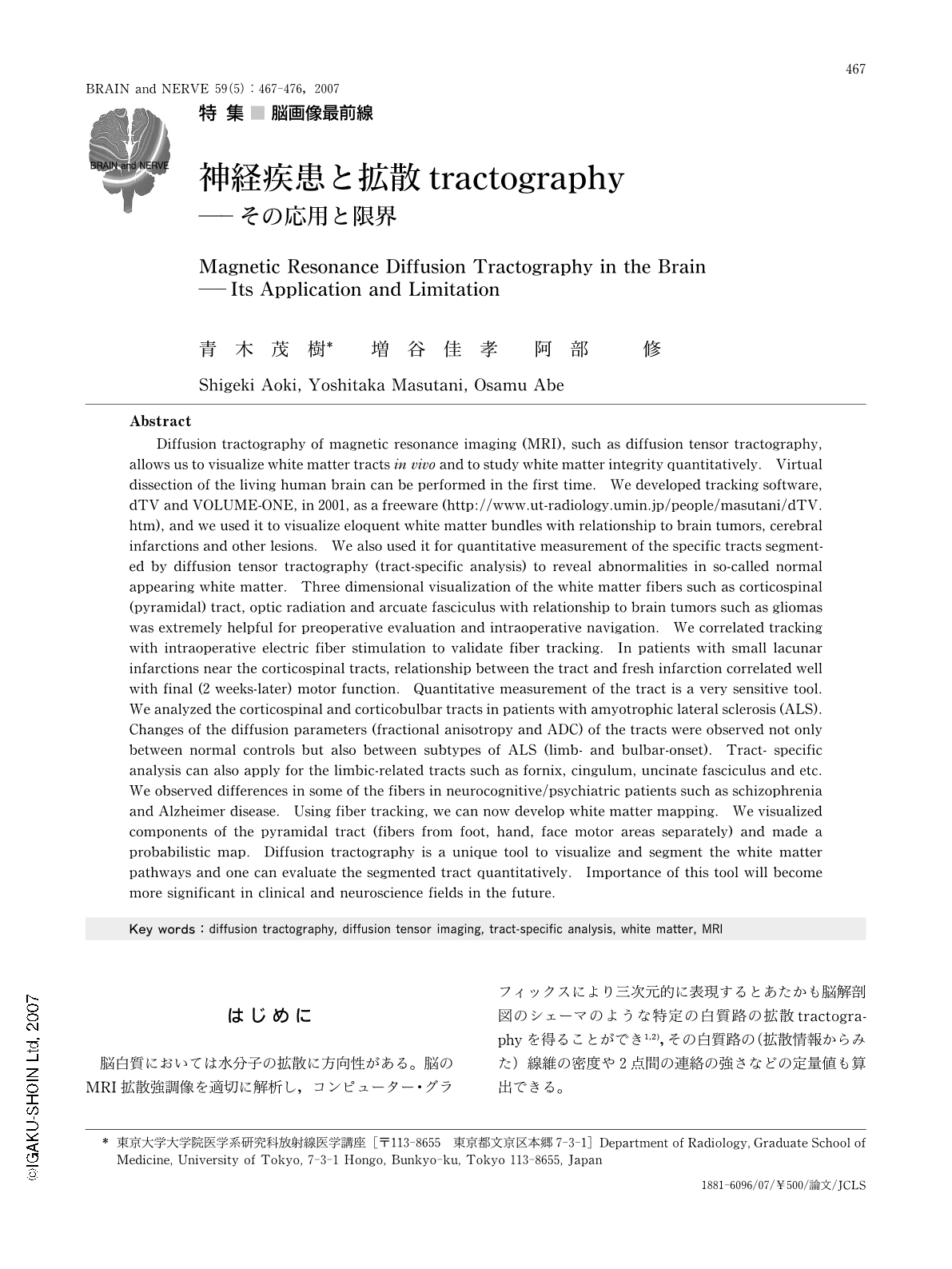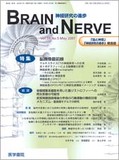Japanese
English
- 有料閲覧
- Abstract 文献概要
- 1ページ目 Look Inside
- 参考文献 Reference
はじめに
脳白質においては水分子の拡散に方向性がある。脳のMRI 拡散強調像を適切に解析し,コンピューター・グラフィックスにより三次元的に表現するとあたかも脳解剖図のシェーマのような特定の白質路の拡散tractographyを得ることができ1,2),その白質路の(拡散情報からみた)線維の密度や2点間の連絡の強さなどの定量値も算出できる。
拡散テンソルに代表される拡散解析は今までin vivoに観察することが困難であった主要脳白質路を描出し,それを定量的に評価できるという他の方法にない特徴をもつ3-8)。拡散テンソルtractographyは臨床的には皮質脊髄路などの主要白質路と脳腫瘍9-11)や脳梗塞などとの立体的関係を三次元的に描出することができる点(Fig.1)が高く評価されている。手術のアプローチの決定や脳梗塞の予後予想などでの有用性が報告され12,13),手術ナビゲーション14,15)や定位放射線照射と組み合わせた報告16)も出てきている。
こういった目に見える病巣と白質路の立体的関係のみならず,従来の方法では描出されなかった白質の微細な変化を捉えようという研究も急速に進んでいる17)。まずALS(amyotrophic lateral sclerosis)のように特定の白質路の障害が強く予想される疾患で異常が検出可能であることが確認され18,19),白質のdisconnectionが病因として注目されている統合失調症での報告も相次いでいる20)。疾患だけでなく,正常での線維連絡や白質のmaturation,加齢変化の検討もなされている。大脳皮質と視床との線維連絡などの検討には,多軸の撮像とシミュレーションを用いるprobabilistic tractographyが有用との報告もあるが,錐体路や鉤状束,帯状束,脳弓などの比較的太い,あるいは独立した白質路に関しては,拡散テンソルによる解析でも大きな差は出ないようである21)。
ここでは筆者らのグループでの経験を中心に拡散tractographyの現状を述べ,最後によく聞かれる質問とその回答をまとめてみた。
Abstract
Diffusion tractography of magnetic resonance imaging (MRI),such as diffusion tensor tractography,allows us to visualize white matter tracts in vivo and to study white matter integrity quantitatively. Virtual dissection of the living human brain can be performed in the first time. We developed tracking software,dTV and VOLUME-ONE,in 2001,as a freeware(http://www.ut-radiology.umin.jp/people/masutani/dTV.htm),and we used it to visualize eloquent white matter bundles with relationship to brain tumors,cerebral infarctions and other lesions. We also used it for quantitative measurement of the specific tracts segmented by diffusion tensor tractography (tract-specific analysis) to reveal abnormalities in so-called normal appearing white matter. Three dimensional visualization of the white matter fibers such as corticospinal (pyramidal) tract,optic radiation and arcuate fasciculus with relationship to brain tumors such as gliomas was extremely helpful for preoperative evaluation and intraoperative navigation. We correlated tracking with intraoperative electric fiber stimulation to validate fiber tracking. In patients with small lacunar infarctions near the corticospinal tracts,relationship between the tract and fresh infarction correlated well with final (2 weeks-later) motor function. Quantitative measurement of the tract is a very sensitive tool. We analyzed the corticospinal and corticobulbar tracts in patients with amyotrophic lateral sclerosis (ALS). Changes of the diffusion parameters (fractional anisotropy and ADC) of the tracts were observed not only between normal controls but also between subtypes of ALS (limb-and bulbar-onset). Tract-specific analysis can also apply for the limbic-related tracts such as fornix,cingulum,uncinate fasciculus and etc. We observed differences in some of the fibers in neurocognitive/psychiatric patients such as schizophrenia and Alzheimer disease. Using fiber tracking,we can now develop white matter mapping. We visualized components of the pyramidal tract (fibers from foot,hand,face motor areas separately) and made a probabilistic map. Diffusion tractography is a unique tool to visualize and segment the white matter pathways and one can evaluate the segmented tract quantitatively. Importance of this tool will become more significant in clinical and neuroscience fields in the future.

Copyright © 2007, Igaku-Shoin Ltd. All rights reserved.


